There’s nothing quite like the aroma of freshly baked bread wafting through the house, especially when it’s Rustic Sourdough Bread made with Sourdough Bread Starter. This recipe is 25% whole wheat with a touch of maple syrup, giving this rustic bread a soft, chewy crumb, and earthy flavor. Made with five simple ingredients, it has a long overnight rise with little hands-on mixing, shaping, and baking time. This recipe is vegetarian or vegan.
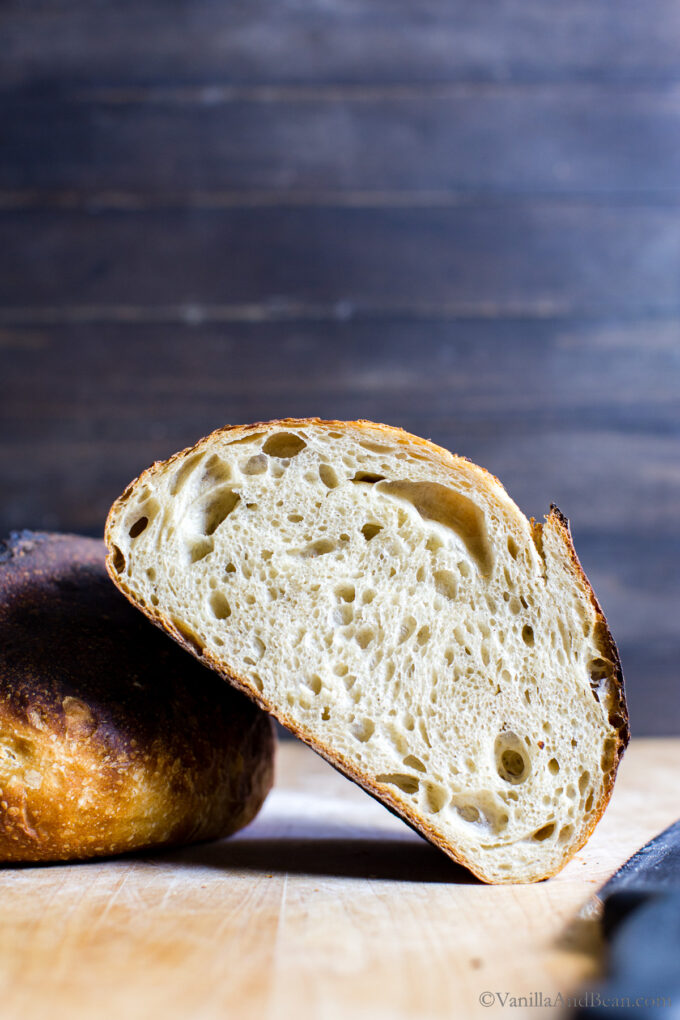
Table of Contents
A Rustic Sourdough Bread Recipe Using Starter
Mmmmmm can you smell it? When sourdough is in the oven, it reminds me of those early mornings in pastry school and at the bakery. Good thing we can recreate that aroma at home. Fresh-baked homemade sourdough bread, makes the house smell like a bakery!
Like this Multigrain Sourdough Bread and my Gluten Free Multigrain Sourdough Bread, this rustic sourdough recipe is perfect for sandwiches and toast, but also for Sourdough Croutons, as a base for tartines and all your soup dunking needs.
Slather with Rhubarb Freezer Jam, Pumpkin Butter, or Blueberry Compote, for the ultimate toast, or go savory with this Avocado Toast with Roasted Asparagus.
This Rustic Bread Is
- soft and chewy on the inside, crusty on the outside
- earthy and with a hint of sour
- 25% whole wheat
- made with a long overnight rise
If you make homemade sourdough recipes, you’ll enjoy this soft interior, crusty exterior sourdough recipe.
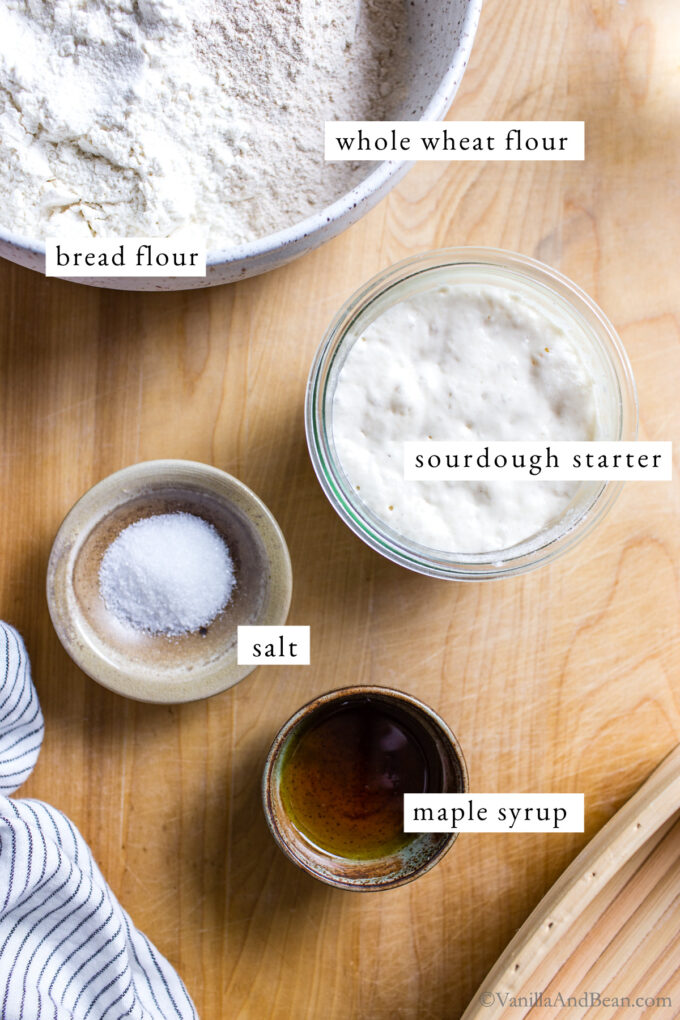
Ingredients You’ll Need
Five pantry friendly ingredients come together to make a fabulous sourdough loaf. Here’s what you’ll need to make this rustic sourdough bread (see recipe card for details):
- Ripe Sourdough Starter – use a 100% hydration, doubled in size sourdough bread starter.
- Unbleached Bread Flour – with higher protein than all purpose flour, bread flour creates a lofty rise and sturdy structure. I like Organic King Author Flour brand.
- Whole Wheat Flour – offers earthy flavor and softens the texture of the bread. Use stone ground whole wheat for best flavor and nutrition. I like Bob’s Red Mill Organic Stone Ground Whole Wheat Flour brand.
- Maple Syrup – I use just a touch for complex flavor. It also aids in giving this bread its rich golden-brown color. You can use maple syrup or honey in this recipe.
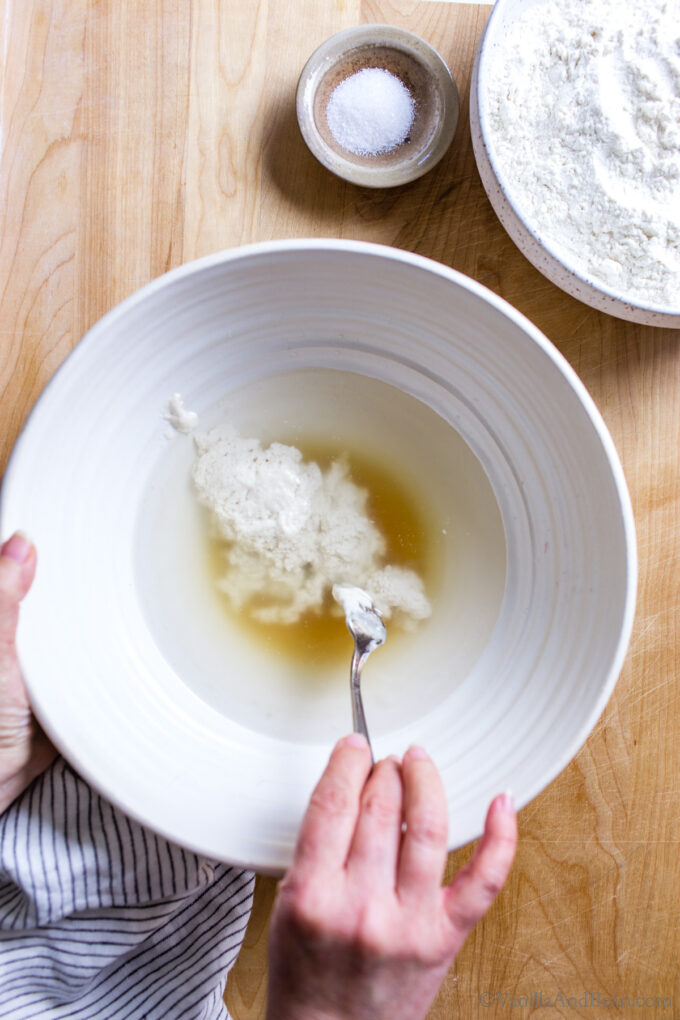
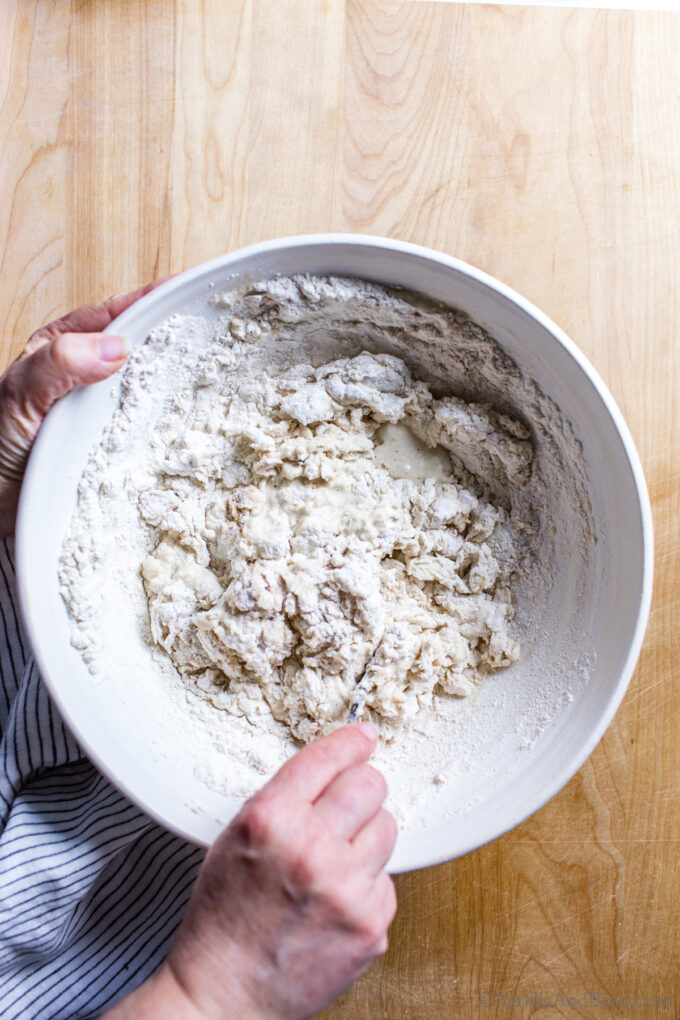
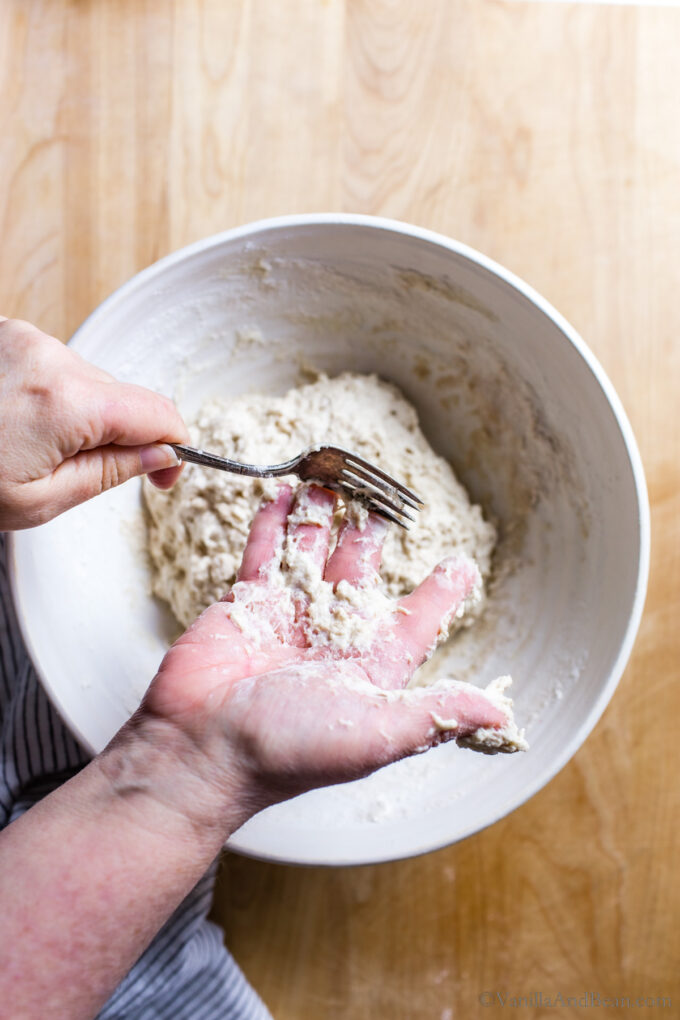
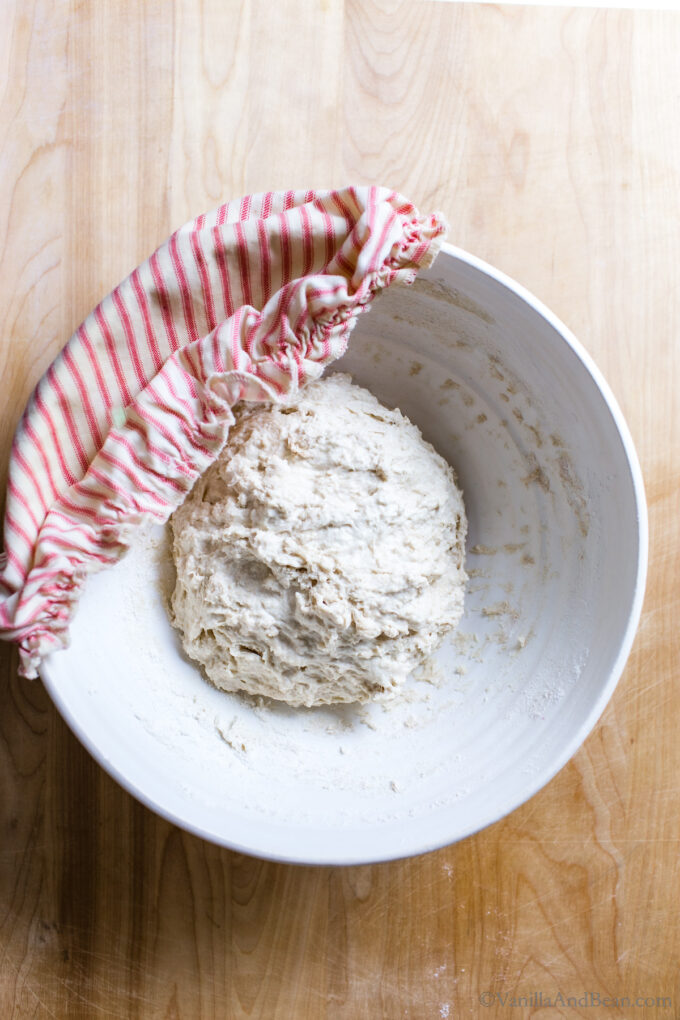
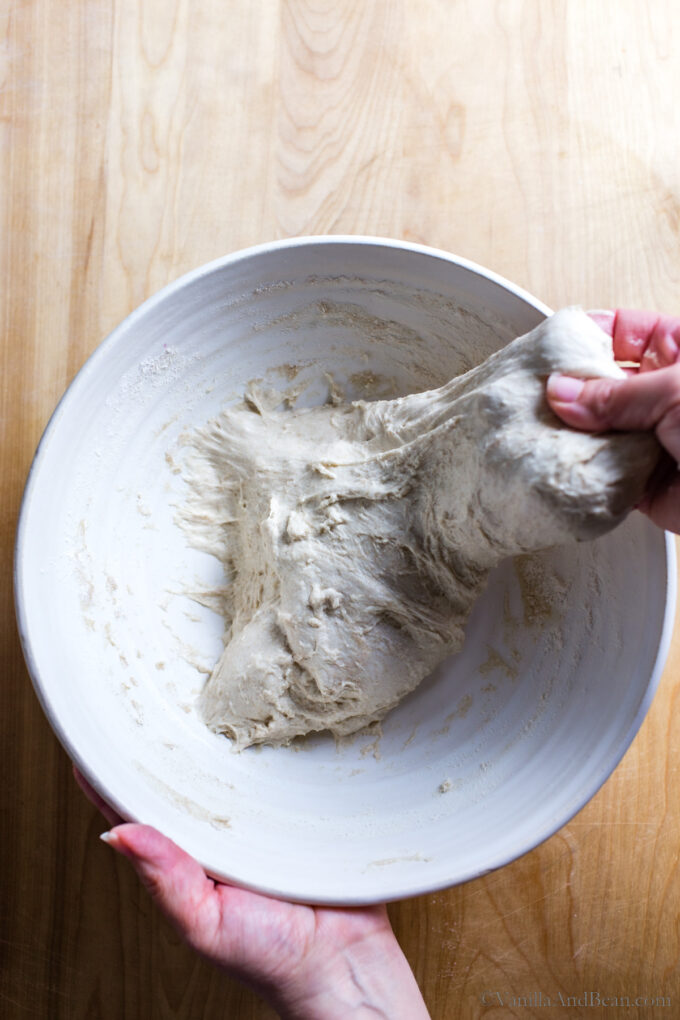
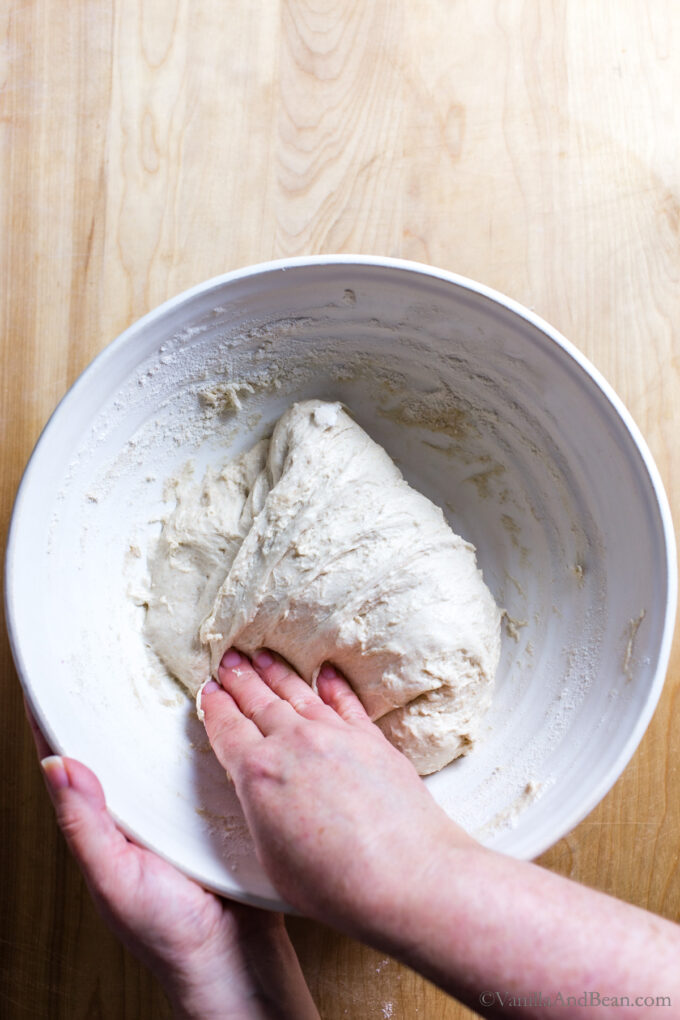
Quick Guide: How to Make Homemade Rustic Sourdough Bread
Making sourdough bread is pretty straightforward but it takes a bit of planning. However, like all sourdough bread, hands on time is short while hands off time is longer for fermentation, proofing, and baking. I always seem to think about it more than the time it actually takes to make bread (ha!).
I typically mix the night before and bake on a weekend morning because I have a bit more flexibility then. While you sleep, your little dough baby is growing! In summary, here’s how to make this recipe (see recipe card for details):
- First, in a large mixing bowl, mix your previously fed, doubled in size sourdough starter with water and maple syrup.
- Second, add the flours and salt. Mix using a fork first, then your hand.
- Third, cover and allow the bread to rest for 45 minutes at room temperature.
- Fourth, perform a series of 2-3 folds with a 45 minute rest in between.
- Fifth, bulk ferment the dough at room temperature for 12-14 hours or until it about doubles in size. Time will depend on ambient temperature, and your specific sourdough starter.
- Next, shape the dough into a boule or batard (as seen in these pictures), then proof the dough for about 30 minutes at room temperature.
- Last, score and bake!
Allow the bread to cool completely before slicing into the loaf. A practice in patience.
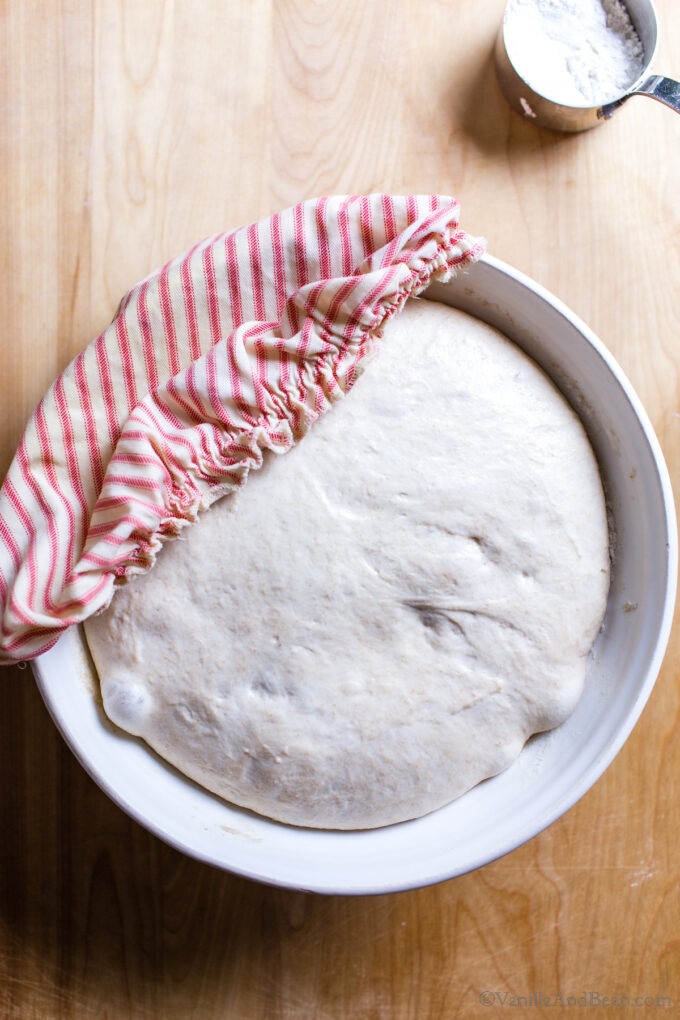
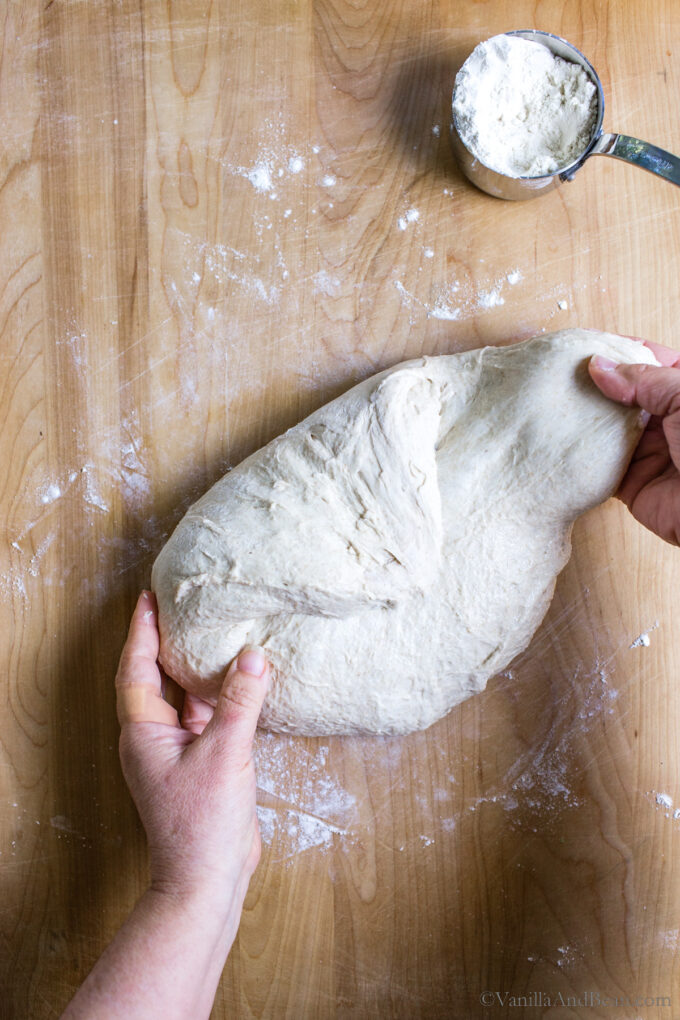
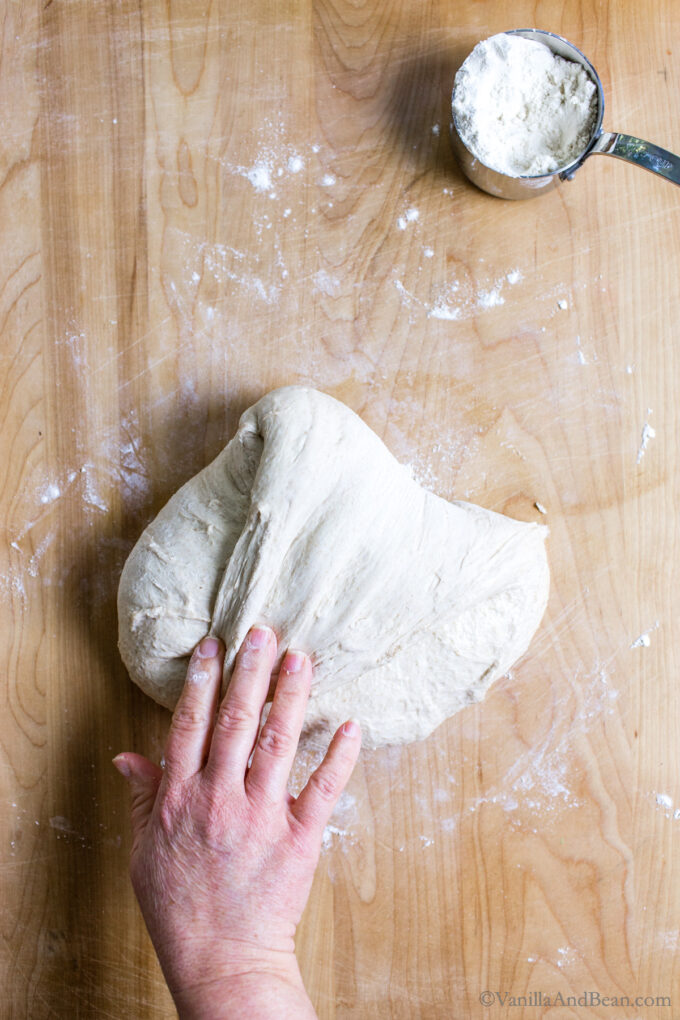
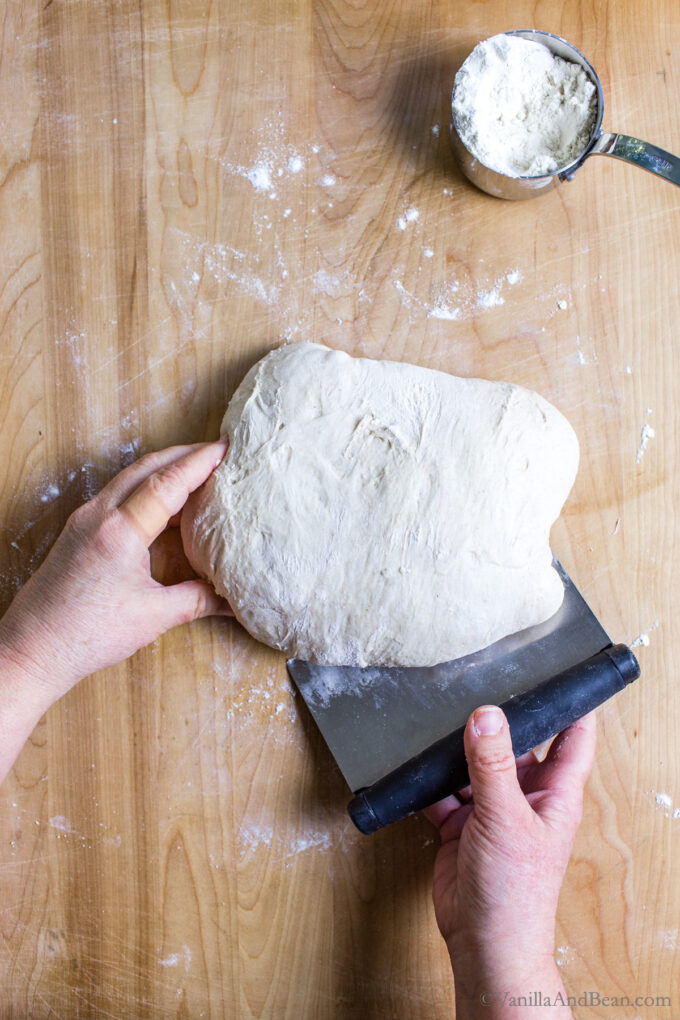
How Long Does it Take for Sourdough to Rise?
- The first rise, or bulk ferment time depends on several factors: ambient temperature, specific ingredients like whole wheat and sugar, and how active your starter is. A firmer dough will take longer to rise than a well hydrated dough.
- When fermenting at room temperature, bulk rise time in summer will generally be quicker than winter rise times.
- An ambient temperature of 70 Fahrenheit (21 Celsius) will require a bulk rise time of about 10-12 hours. In a cooler kitchen the dough can take up to 12-14 hours to rise – this is the norm in my chilly kitchen at 68 Fahrenheit (18 Celsius). Use the time as a guide and not a determining factor.
How To Tell When Sourdough Has Risen Enough
It takes a bit of practice to tell when the dough has risen enough. Since I don’t use a Cambro or other straight sided transparent vessel for fermenting sourdough, I look for other cues to tell when the dough is ready for shaping.
Bulk fermented (first rise) dough is ready when:
- it no longer looks or feels dense
- is jiggly when the bowl is wiggled – really jiggly!
- has about doubled, or a little more, in size
- you may see a few large bubbles on the surface of the dough
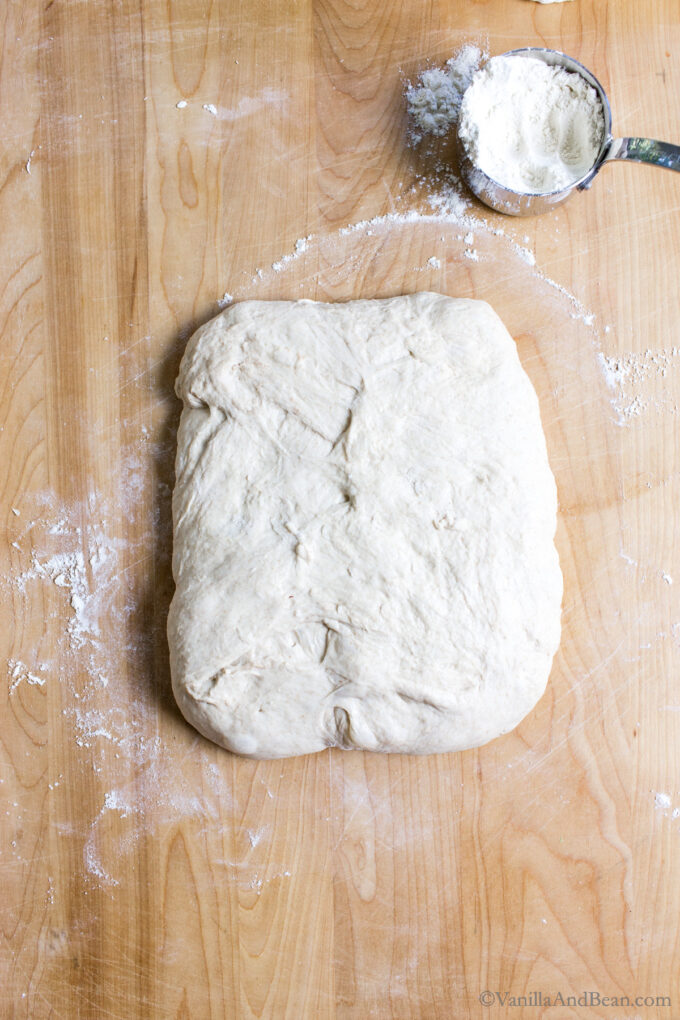
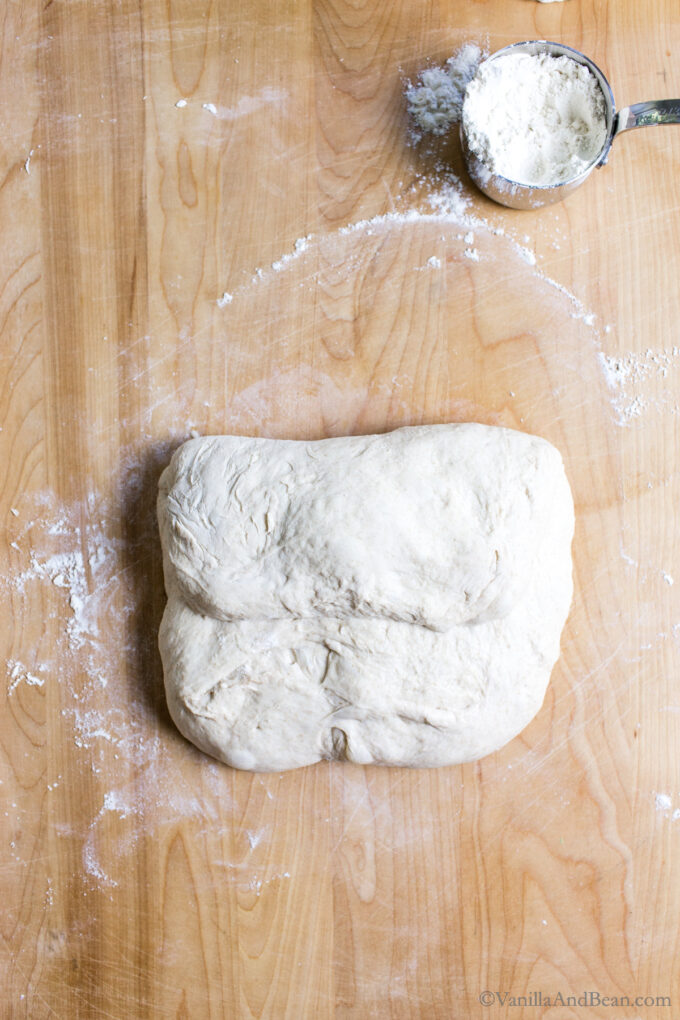
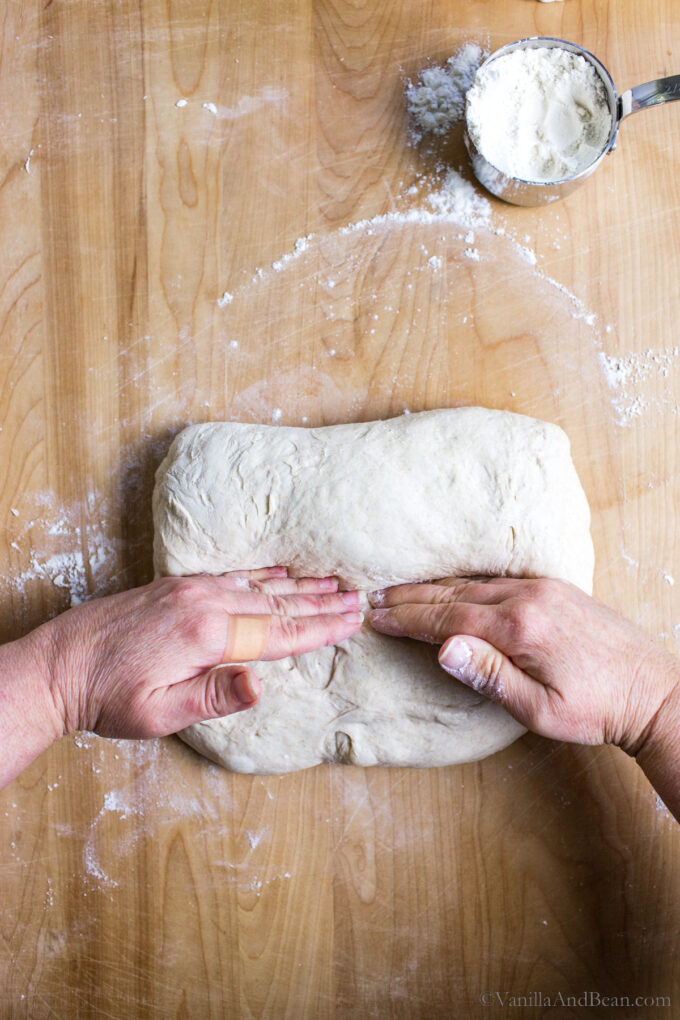
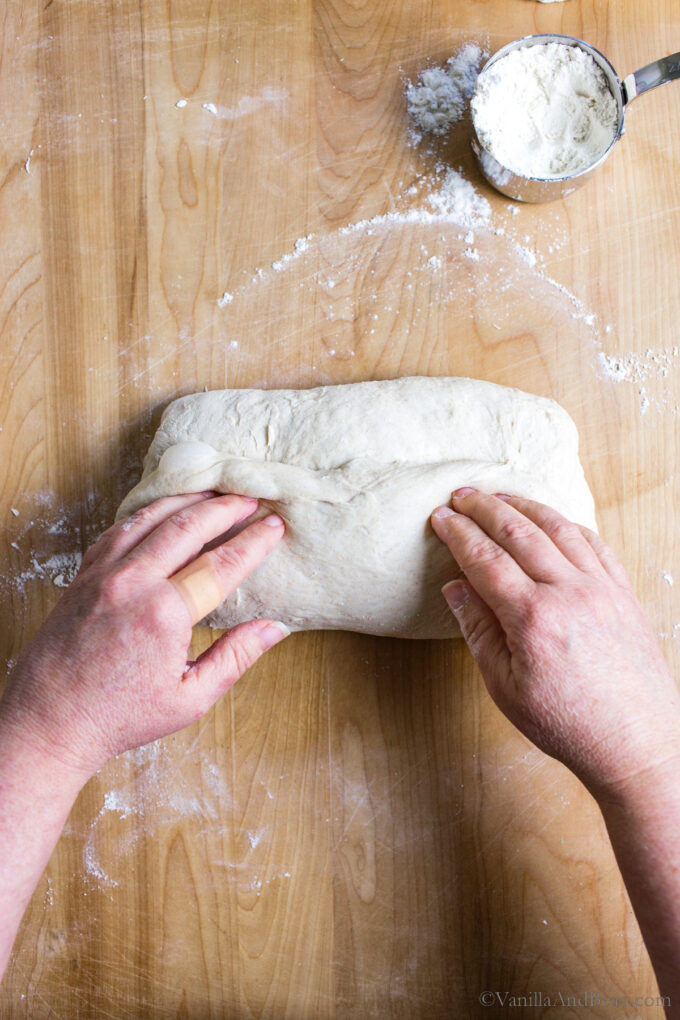
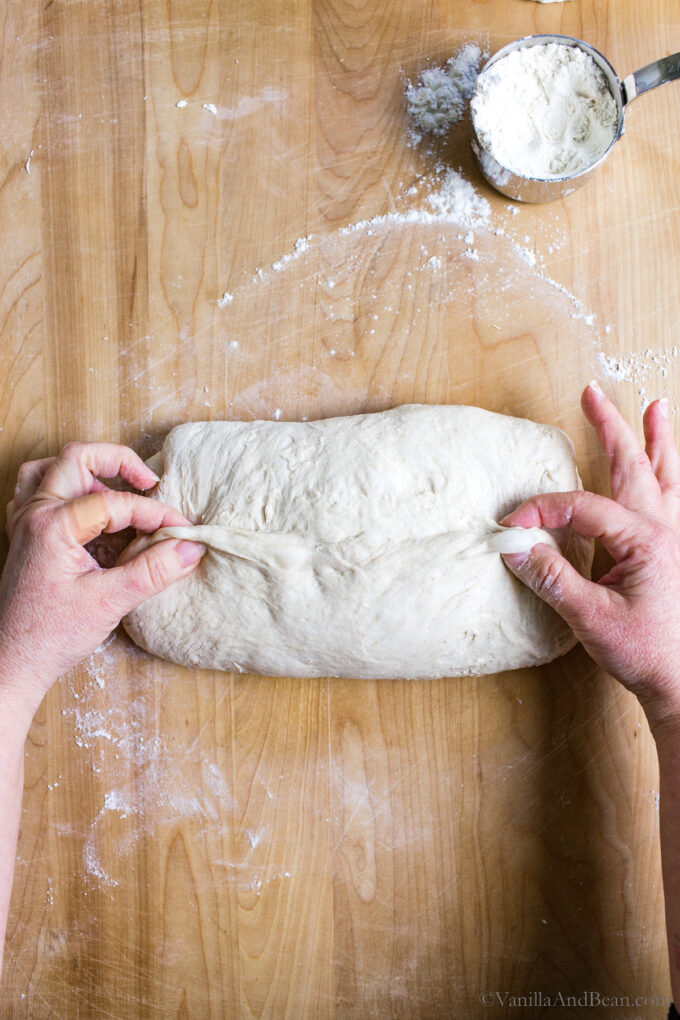
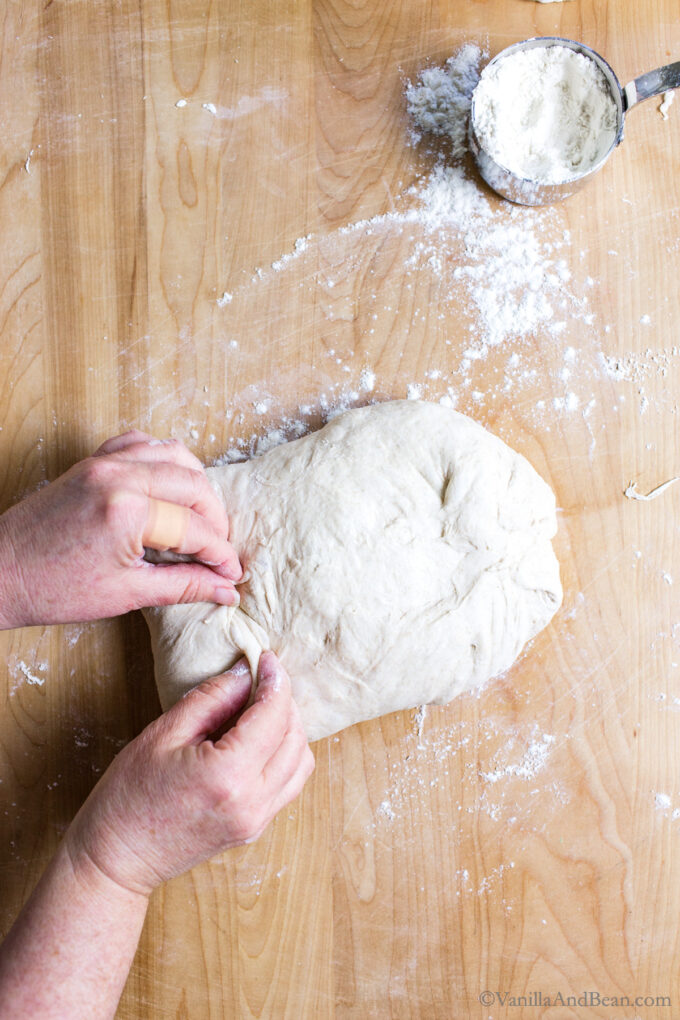
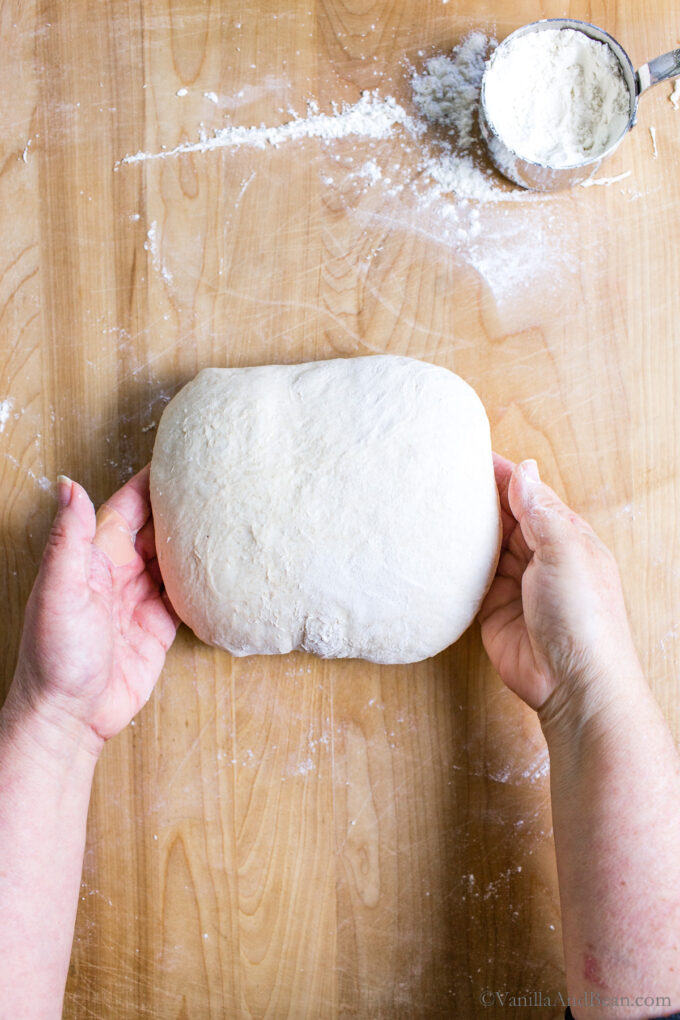
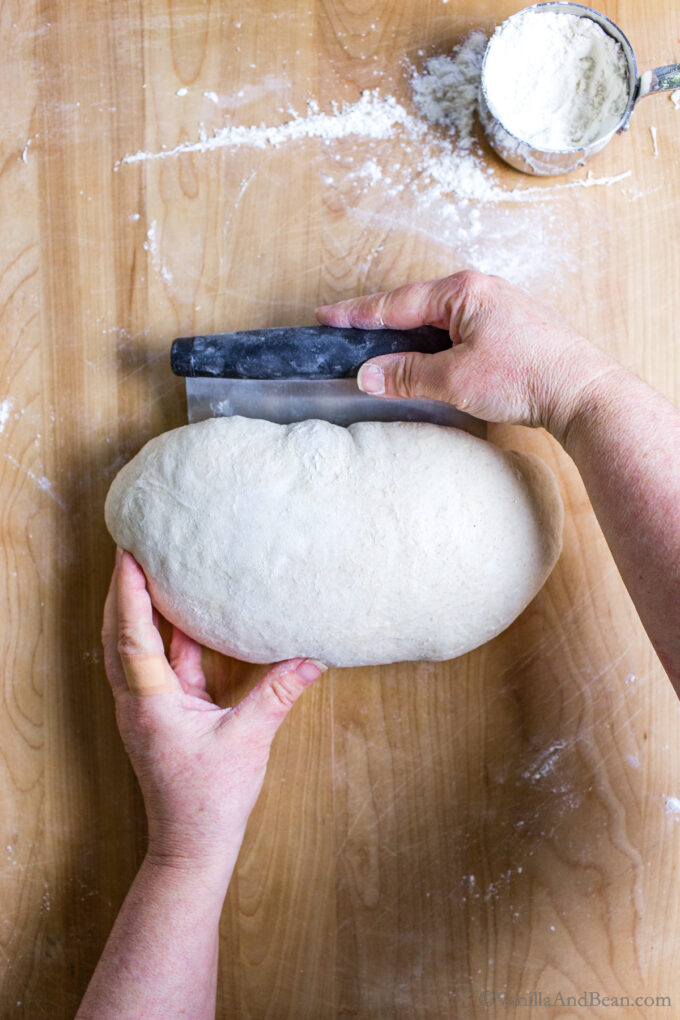
What’s the Best Vessel to Bake Sourdough Bread In?
When baking sourdough bread, consider how you’ll shape the dough. This will guide your choice in baking vessel. I use two different vessels to bake sourdough bread. One is a 10 inch cast iron skillet with deep dish skillet for a lid and the other, a round 7 quart Staub Dutch oven. I recommend either or both.
A boule, or round shape, will fit in either vessel, but if you’re shaping a batard, you’ll need to use either a 10 inch cast iron skillet (pictured in this blog post), oval, 7 quart Dutch oven, or a cloche style baker that will accommodate the dough’s longer shape.
Got sourdough discard? Use it in other quicker to make sourdough recipes! Check out my collection of Sourdough Discard Recipes.
How to Store Rustic Sourdough Bread
Properly storing homemade bread is essential to keeping it soft and delicious. Sourdough bread is best enjoyed the day it’s made. However, it can be stored for several days at room temperature or in the freezer for longer storage.
- Room Temperature: store sourdough bread at room temperature on a cutting board or counter, cut side down. Although freshest the day made, it will store this way for 3-4 days. If you need to cover the bread, place it in a paper bag.
- PRO TIP: refrigerating bread dries it out and will ruin its texture.
- Freezer Storage: to keep your bread at its freshest, transfer sliced bread to a freezer bag and freeze for up to two weeks. Your bread can go from freezer to toaster oven for the tastiest toast. Alternatively, gently thaw by partially toasting the bread, or at set the bread out room temperature in a covered container.
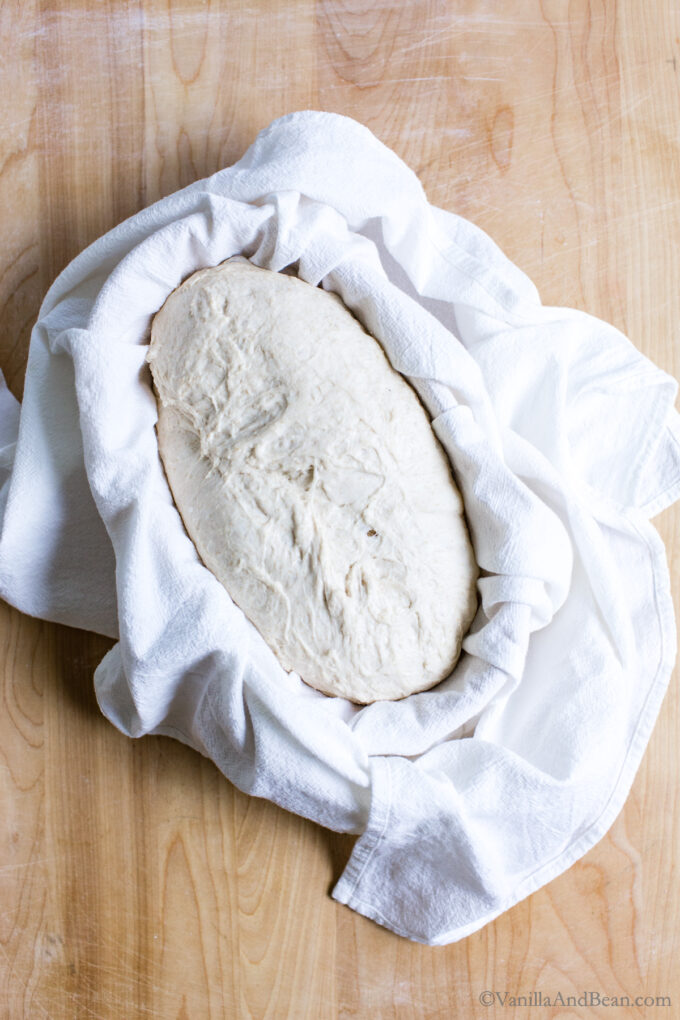
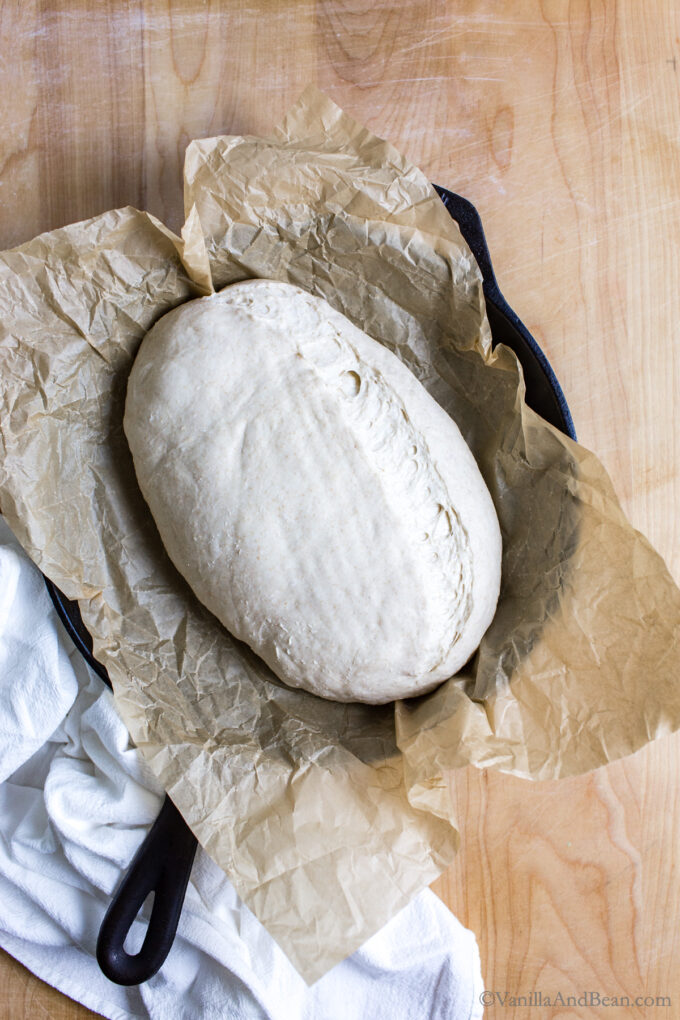
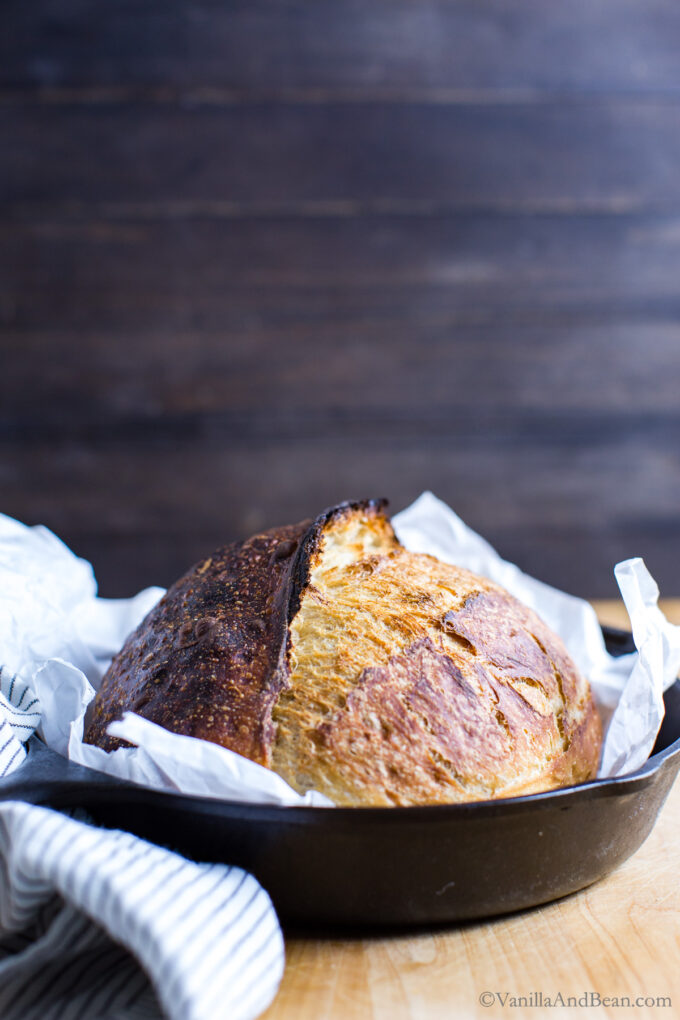
Sourdough Baking Tools
There are a few tools sourdough bakers have in their tool chest. These are among my favorite and most used (these are affiliate links):
- Ceramic, wood, stainless steel or Glass Mixing Bowl – I like to be consistent with the bowl I use so that I can easily tell when the first rise has about doubled in size. But, it’s interesting to compare different vessels as they all have different insulating properties.
- 7 Quart Dutch Oven – use a large round Dutch oven for boules and an oval shape Dutch oven for batards.
- 10 Inch Cast Iron Skillet with Deep Dish Skillet for a lid – I use this for all my Batards since this shape doesn’t fit into my round 7 quart Dutch oven.
- Bench Scraper – super helpful to keep the workspace clean and for shaping the dough. It’s a bakers must have tool.
- Parchment Paper – used as a vehicle to transfer the dough from banneton to baking vessel.
- A Digital Food Thermometer – allows an instant internal temperature of the bread, ensuring the sourdough is done or needs a little more time.
- Bread Lame – for scoring the dough. I use this bread lame from Etsy. It’s beautifully crafted and allows for ultimate scorning control.
- Banneton(s) – for this recipe, I use a 9 inch round or 10 inch oval banneton for proofing depending on how I want to shape the dough. You can use a 9 inch bowl to proof your dough if you don’t have a banneton. Pictured, I use the oval banneton and line it with a flour sack. This doesn’t allow for pretty concentric circle flour lines in the dough post baking, but if you’re worried about sticking or just want to see some beautiful crust, flour sacks won’t stick to the dough and you can see blistered crust. This banneton starter kit on Amazon is a good value if just getting started.
- Digital Scale – for precise baking, and best outcome, it’s no wonder professional bakers weigh their ingredients!
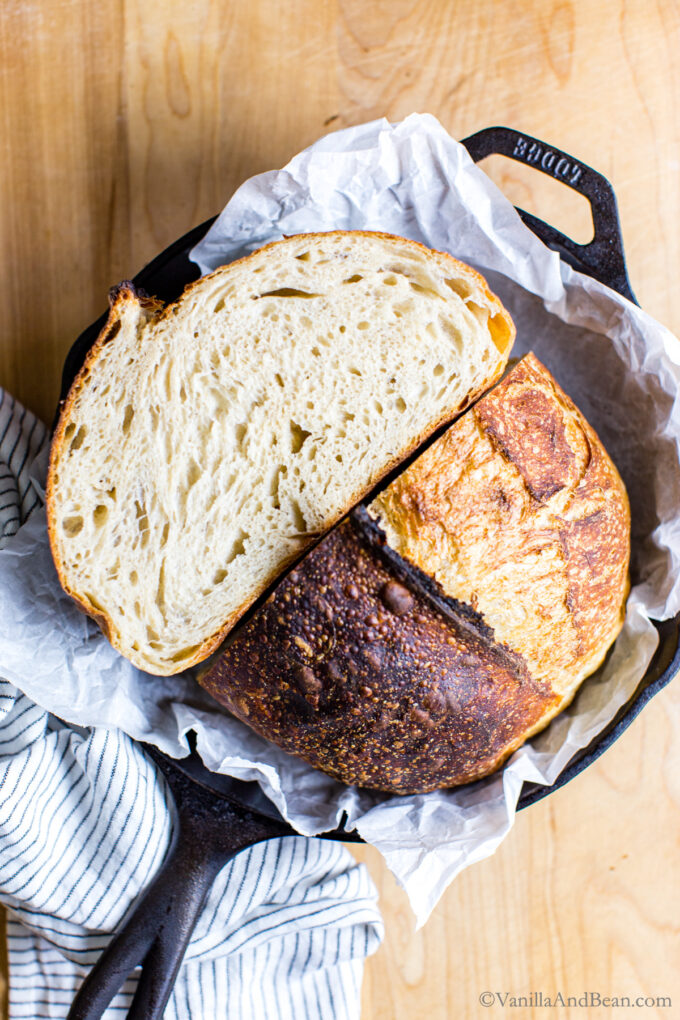
Pro Tips
- Starter: If you need a starter, check my recipe on how to make a Sourdough Bread Starter.
- Timing: Because kitchen temperatures vary, be sure to use the time suggestions in the recipe as such. Let the dough guide your process rather than the clock.
- Hydration: As written, this recipe has a hydration of 75%. This produces a chewy, more open crumb, but the dough is more challenging to shape. For a tighter crumb and easier shaping, you can reduce the hydration to 65%. See notes on the recipe card.
- Shaping: Shaping a batard has presented me with more shaping challenges than shaping a boule or sandwich bread, especially if the dough is of higher hydration, like this loaf. Also, there are multiple ways to shape a batard from easy to more involved. I’ve taken the easier route here and shape this loaf similar to my Maple Oat Sourdough Sandwich Bread. It’s more straightforward and easier to get a taught skin than a fold and roll method.
- Crust too Dark?: If the sourdough is getting too dark after the lid is removed, protect the crust by placing a tented piece of foil over the top of the loaf. To protect the bottom from getting too dark, place a sheet pan on the rack under the rack your baking vessel is setting on.
More Sourdough Recipes to Try
- Sourdough Pita Bread
- Sourdough Chocolate Chip Cookies – use discard
- Easy Sourdough Discard Biscuits
- Soft Sourdough Dinner Rolls
- Cranberry Orange Sourdough Bread
Rustic Sourdough Bread Recipe
Ingredients
- 1/2 cup (100 grams) Sourdough Starter 100% hydration, previously feed and bubbly
- 1 1/2 cup + 1 tablespoon (350 grams) Water 80 Fahrenheit (26 Celcius)* see note for a lower hydration tip
- 2 tablespoons (40 grams) Maple Syrup or honey
- 1/2 C + 2 tablespoons (100 grams) Whole Wheat Flour
- 2 1/2 cups + 1 tablespoon (375 grams) Unbleached Bread Flour
- 1 1/2 teaspoons (13 grams) Fine Sea Salt
Instructions
- Mix the Dough: In the evening, whisk the starter, water, and maple syrup together in a large bowl with a fork. Add the flours and salt. First, mix with a fork, the dough will be shaggy. Then mix by hand, mixing, folding and pushing the dough until the flour is fully incorporated and no dry bits are present. It will seem dry at first, but the more you work the dough, the more hydrated it will become. The dough will become moist and sticky and it will stick to your fingers as you go. Do this for about 3-4 minutes. Use the fork to scrape off the dough on your fingers as much as you can. Cover bowl with a damp tea towel. Set a timer for for 45 minutes and allow the dough to rest for 45 minutes. Now is a good time to feed/refresh your starter.
- Fold the Dough: After the dough has rested, fold the dough. To do this, grab a portion of the dough while it remains in the bowl, stretch it up and fold it over, pressing your fingertips into the center of the dough. You'll notice the dough is sticky and stretchy at this point. Repeat, until you've worked your way around the dough. This is the first fold, and you can stop here and begin bulk fermentation, but If time permits, and optimally, you'll want to repeat at least one to two more times as it improves the final dough's structure and crumb. Allow for about 45 minutes between folds.
- Bulk Fermentation (first rise): After the last fold, cover the bowl with two damp towels and allow to rise overnight at room temperature (see note** on optionally retarding the dough). This will take about 8-10 hours at 70 Fahrenheit (21 Celsius), but in a cooler kitchen the dough can take up to 12-14 hours to rise – this is the norm in my chilly kitchen at 68 Fahrenheit (18 Celsius). Use the time as a guide and not a determining factor. The dough is ready when it no longer looks dense, is jiggly when the bowl is wiggled, and has about doubled in size. You may see some bubbles on top of the dough.
- Shape the Dough: In the morning, and with damp fingertips, coax the dough into a floured work-surface. Pre Shape: With moist fingers, take a portion of the dough, gently stretch it towards you and fold it over towards the center, pressing it down gently. Repeat this process until you work all the way around the dough. Using a bench scraper flip the dough over, cover with a tea towel rest the dough for about 15-20 minutes. Meanwhile, line a 10 inch oval banneton with a flour sack (as seen in the photos) or you can lightly dust the banneton with flour (I like to dust with white rice flour). Alternatively, you can use a 9 inch round banneton or bowl, following my Multigrain Sourdough Bread for shaping.Shape the Dough: Flour the work surface and using a bench scraper flip the dough back over. Use the photos in the blog post to help guide shaping. Gently shape the dough into a rough rectangle by gently dimpling the dough (think focaccia), to roughly 6-7 inches wide and 8-9 inches long. Fold the short side 2/3 over onto itself towards you and crease it firmly using the pinky side of your hand. Fold the bottom 1/3 piece up towards the crease and pinch the seam closed. Fold in the ends, coming in about an 3/4 inch – 1 inch and pinch the seam closed. Flip the bread over, seam sides down and rock it back and fourth a bit and gently fluff the ends in. Cover with a tea towel and allow the dough to rest for about 5-10 minutes. Using lightly floured hands and/or your bench scraper, cup the back of the dough and gently pull it towards you as needed until the surface is taught. Gently "fluff" the ends in again if needed to fit into the banneton. If not using a flour sack to line the banneton, sprinkle flour over the surface of the dough and smooth it around with the palm of your hand, covering the top and sides of the dough. Once the surface of the dough is taut and with one swift move, use the bench scraper to scoop the dough up and, place the dough into the prepared banneton – bottom side up.
- Proof the Dough (second rise): Cover the banneton with a damp tea towel and let rest for 30 minutes to 45 minutes. The dough is ready when it looks puffy and has risen slightly but has not doubled in size. Get Ready to Bake: Preheat the oven to 475 Fahrenheit (245 Celsius). Arrange an oven rack in the center of the oven and place a sheet pan on the bottom rack. This helps prevent a *too* dark bottom. Cut a sheet of parchment paper large enough to fit the size of your lidded baking vessel, I use a 10 Inch Cast Iron Skillet with Deep Dish Skillet for a lid. Crumble the parchment paper, then uncrumble the parchment, and smooth it open for easier handling.
- Score: To turn the dough out of the banneton, place the parchment over the dough and invert the banneton to release onto the parchment. Using the tip of a lame or a razor blade, score the dough about 1/2 inch (8 millimeters) deep, off center, in an gentle arch shape the length of the dough or any way you like. Use the parchment to transfer the dough to the baking vessel and place the lid on the vessel.
- Bake the Dough: Place the vessel into the oven, on the center rack, and bake for 30 minutes at 475 Fahrenheit (245 Celsius) with the lid on. Remove the lid, reduce the oven temperature to 450 Fahrenheit (232 Celsius) and continue baking for another 10-15 minutes tenting the loaf with foil if it starts getting too dark (my ear always gets extra dark).The bread is ready when the internal temperature of the loaf is between 190 – 205 Fahrenheit (87 – 96 Celsius). When done, transfer the bread to a wire rack. Cool completely before slicing.
- Storage Notes: Sourdough is best consumed on the same day it's baked, but it lasts for 3-4 days stored at room temperature. Store at room temperature cut side down.This bread freezes beautifully. Store baked bread, sliced, in a freezer bag either whole or sliced for up to two weeks. Thaw at room temperature. This bread can go straight from freezer to toaster to make the most delicious toast!

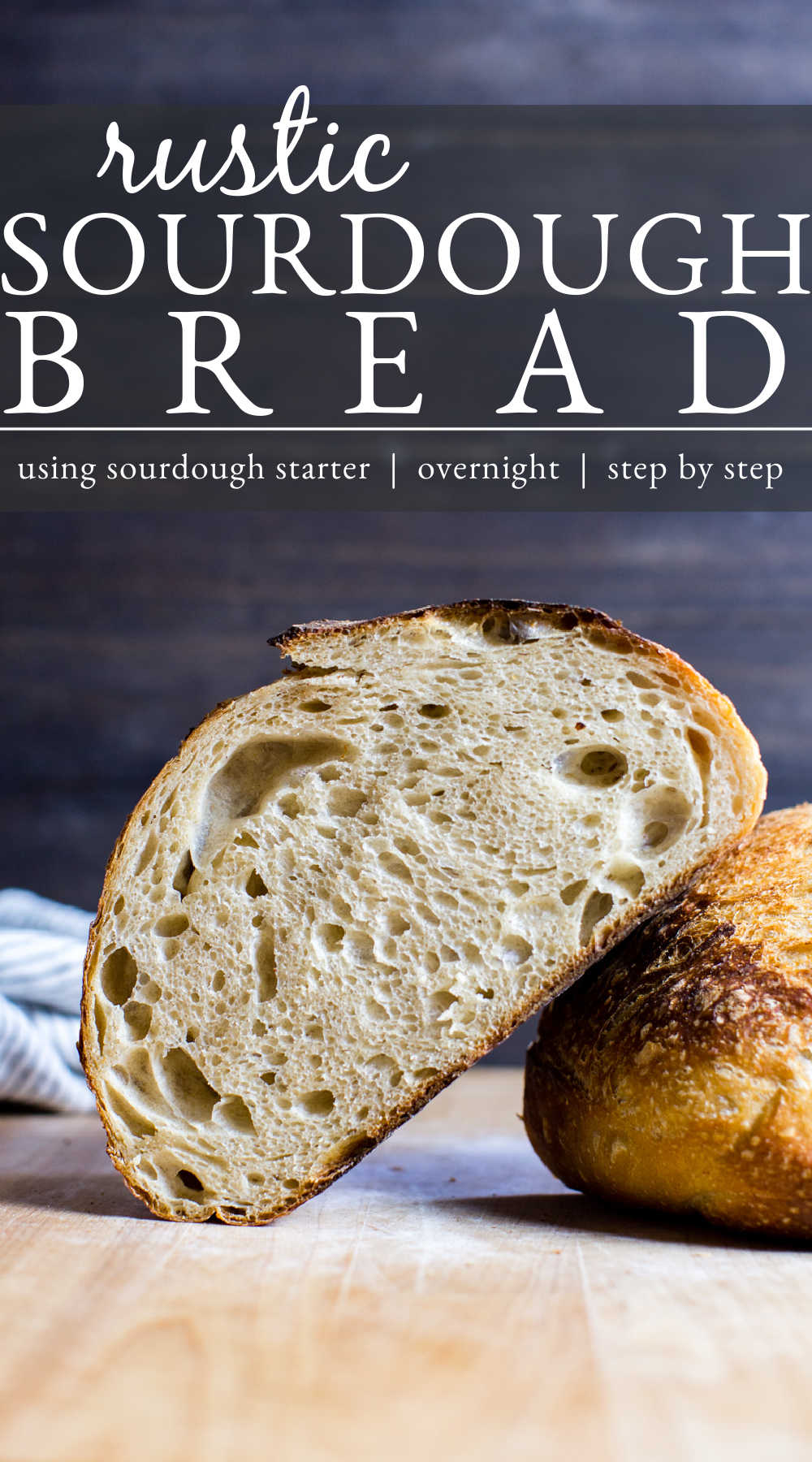
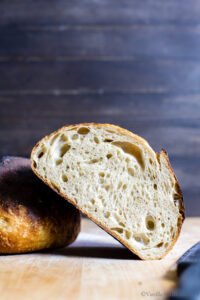
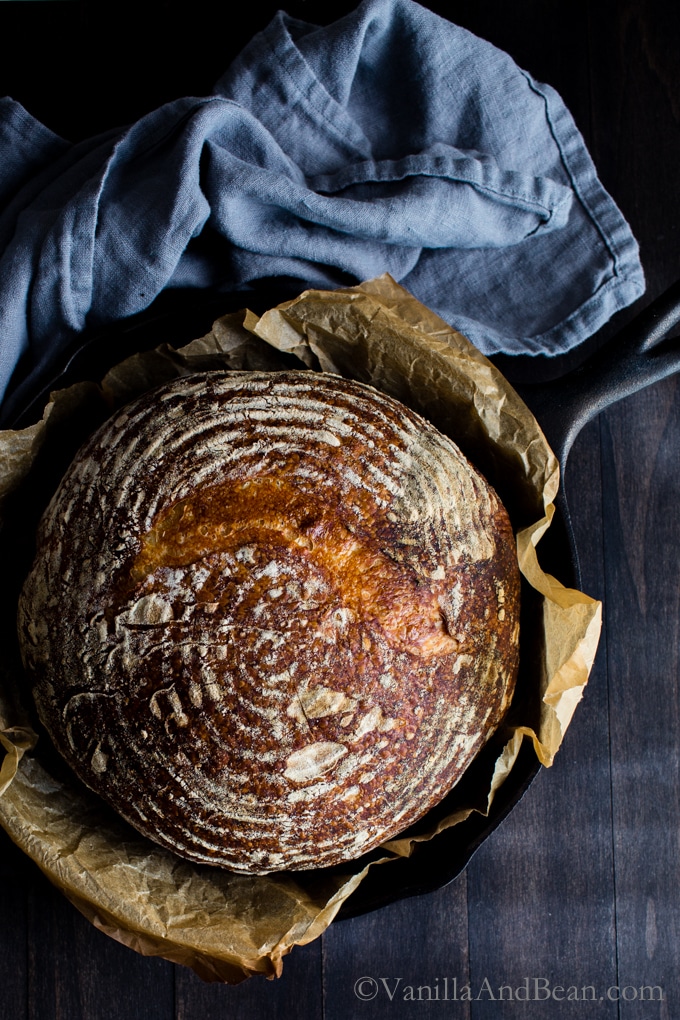
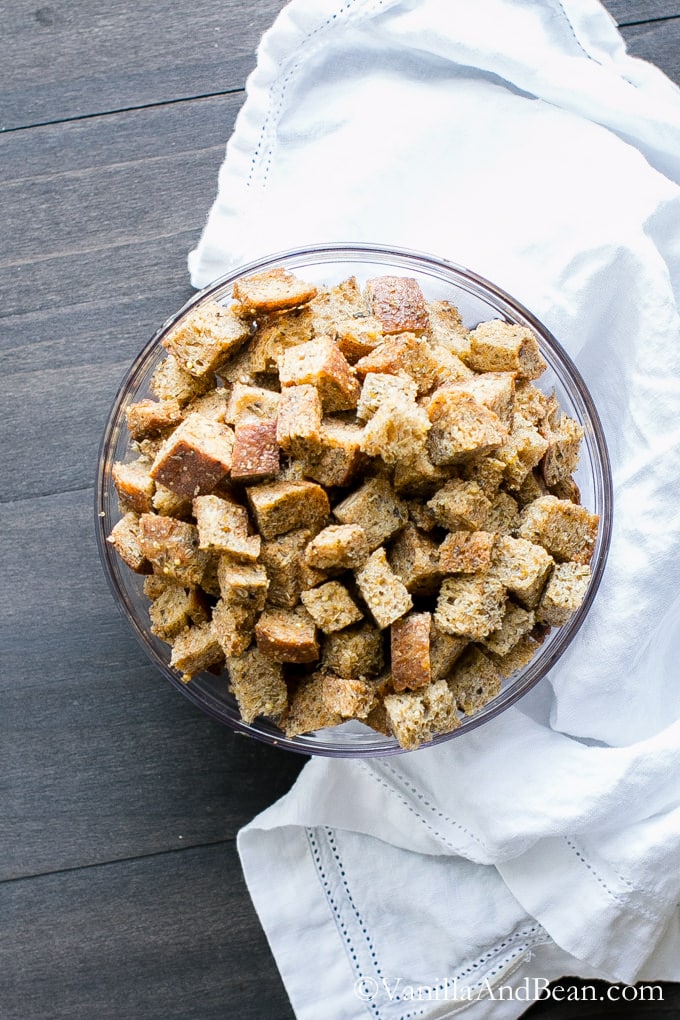
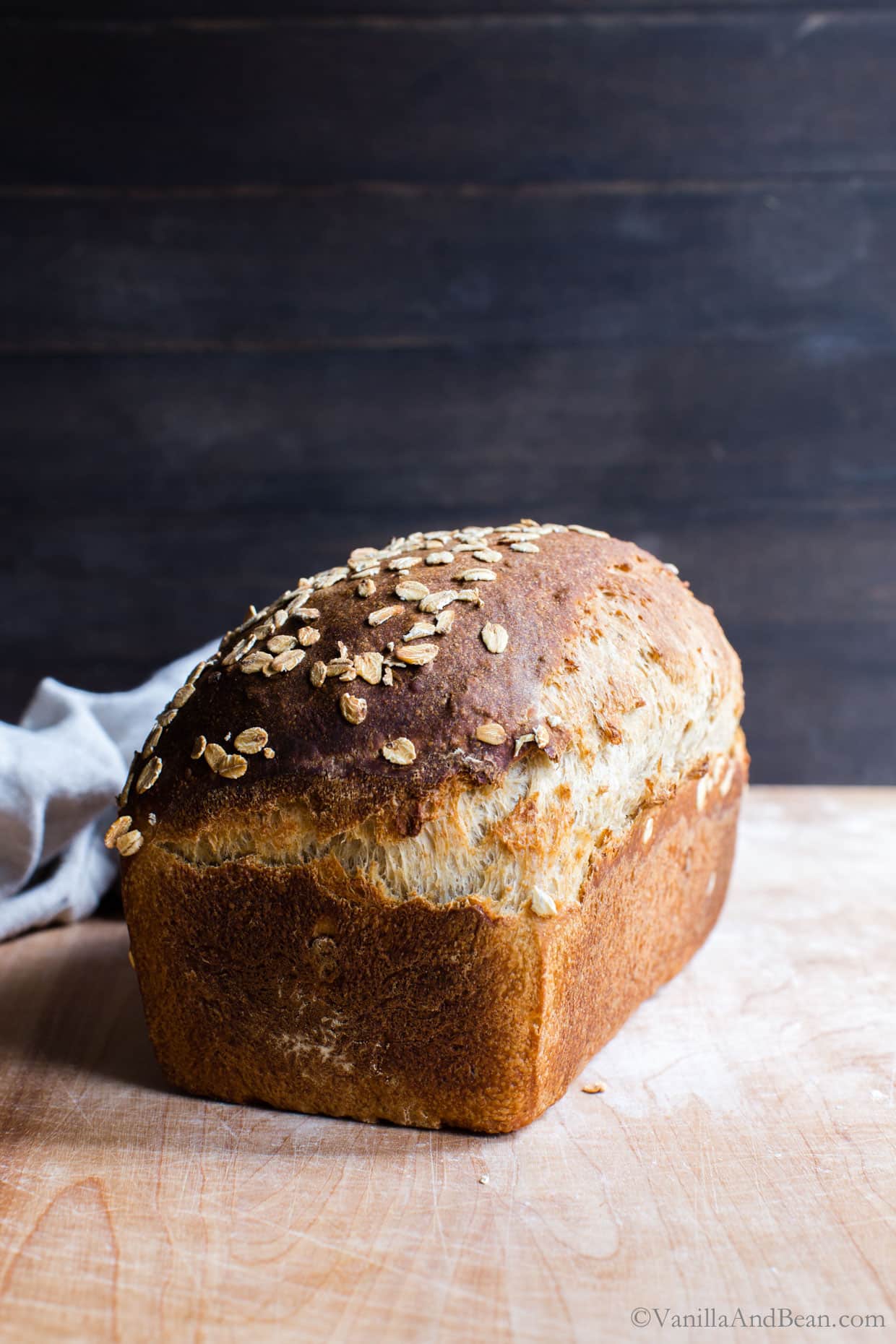
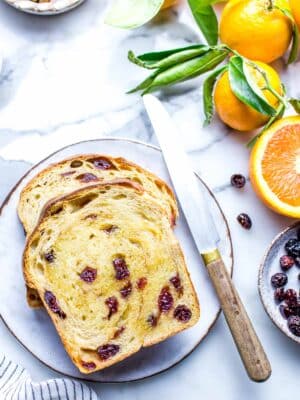
I’m following your recipe and it’s on its first rise. Based on the delicious success of your other recipes, I’m really looking forward to the outcome!
Hii Heather…. so excited! I love this loaf 😍
This recipe is awesome. Simple ingredients and very helpful instructions on how and when to fold, what to expect and tips to keep the bottom from getting burnt. I’ve been making sour dough bread off and on for a couple years, this is the first time I feel I made a true loaf of sour dough bread! My dough rose, jiggled and bubbled when it was supposed to and turned out so good—I feel like a true artisan. Crust was spot on, inside was moist and flavorful. Thank you!
Hi Barb! Thank you for giving the sourdough a go, and five star review. I loved seeing your bread on Instagram and am thrilled you found the process tips helpful!
This recipe was very easy to follow, gave me more understanding of the sourdough process and beautiful success. Thank you for sharing
Thank you for your note, Kimberly and giving the sourdough a go! I loved seeing your bake on Instagram… sourdough perfection!!
Your Sour Dough Bread looks great Traci… I was gonna ask you how much whole grain do you use in your bread but I saw it in the ingredients. I usually add 4 – 5 percents on Rye bread…
Thank you Nathan! 4-5 percent Rye sounds delicious. I’m working on a light rye recipe and have noticed how much the dough changes with the increased rye. Keep us posted if you give this a go with a bit of rye!